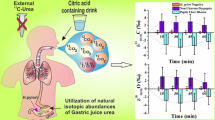Abstract
Previous studies showed that either the urease activity possessed by H. pylori and the bacterial load may influence the results of the [13C] urea breath test. However, the correlation between urease activity and dyspepsia is unclear. The aim of our study was to evaluate whether the urease activity of the gastroduodenal tract may influence the severity of dyspeptic symptoms. In all, 2520 dyspeptic patients (1109 men, 1411 women; mean age 47 ± 16 years) without gastroesophageal reflux disease, diabetes, vascular disorders, liver and biliary tract diseases, and tumors of the gastrointestinal tract and with a normal appearing abdominal ultrasonography were enrolled. All these patients underwent a [13C] urea breath test and filled out a questionnaire on dyspeptic symptoms. Subjects were divided in five different groups according to delta over baseline (DOB) values (group 1 < 3.5, group 2 = 3.5–6; group 3 = 6.1–11, group 4 = 11.1–23, group 5 > 23.1). The prevalence and intensity of dyspeptic symptoms were compared among groups. In all, 1688 patients (67%, 928 females and 760 males; mean age 48 ± 15 years) were H. pylori-positive. The chi-squared test and analysis of variance showed increase of frequency and intensity of each dyspeptic symptom according to DOB values. In conclusion, Dyspepsia may parallel gastric urease activity. However, whether higher DOB values are related to higher bacterial load or, alternatively, to the presence of particular H. pylori strains able to produce larger amounts of urease is uncertain.
Similar content being viewed by others
REFERENCES
Covacci A, Telford JL, del Giudice G, Parsonnet J, Rappuoli R: Helicobacter pylori virulence and genetic geography. Science 284:1328–1333, 1999
McCarthy C, Patchett S, Collins RM, Beattie S, Keane C, O'Morain C: Long-term prospective study of Helicobacter pylori in nonulcer dyspepsia. Dig Dis Sci 40:114–119, 1995
O'Morain C, Gilvarry G: Eradication of Helicobacter pylori in patients with non-ulcer dyspepsia. Scand J Gastroenterol 28:30–33, 1993
Bernersen B, Johnsen R, Bostad L, Straume B, Sommer AI, Burhol PG. Is Helicobacter pylori the cause of dyspepsia? BMJ 304:1276–1279, 1992
Jaakkimainen RL, Boyle E, Tudiver F: Is Helicobacter pylori associated with non-ulcer dyspepsia and will eradication improve symptoms? A meta-analysis. BMJ 319:1040–1044, 1999
Langenberg W, Tytgat GNJ, Schipper MEI, Rietra PJGM, Zanen HC: Campylobacter-like organisms in the stomachs of patients and healthy individuals. Lancet 1:1348, 1984
Graham DY, Klein PD, Evans DJ, Evans DG, Alpert LC, Opekun AR, Boutton TW: Campylobacter pylori detected noninvasively by the 13C-urea breath test. Lancet 1:1174–1177, 1987
Figura N. Are Helicobacter pylori differences important in the development of Helicobacter pylori-related diseases? Ital J Gastroenterol Hepatol 29:367–374, 1997
Bazzoli F, Zagari RM, Pozzato P, Fossi S, Alampi G, Sottili S: 13C-urea breath test to quantify H. pylori colonization of gastric mucosa and association with severity of inflammation. Gastroenterology 106:A48, 1994
Perri F, Clemente R, Pastore M, Quitadamo M, Festa V, Bisceglia M, Li Bergoli M, Lauriola G, Leandro G, Ghoos Y, Rutgeerts P, Andriulli A: The 13C-urea breath test as a predictor of intragastric bacterial load and severity of Helicobacter pylori gastritis. Scand J Clin Lab Invest 58:19–28, 1998
Bukley MJ, Scanlon C, McGurgan P, O'Morain C: A validated dyspepsia symptom score. Ital J Gastroenterol Hepatol 29:495–500, 1997
Talley NJ, Vakil N, Ballard ED 2nd, Fennerty MB: Absence of benefit of eradicating Helicobacter pylori in patients with nonulcer dyspepsia. N Engl J Med 341:1106–1111, 1999
Werdmuller BF, Van der Putten AB, Veenendaal RA, Lamers B, Balk AG, Loffeld RJ: Functional dyspepsia has a good prognosis irrespective of H. pylori status. Long-term follow-up of symptoms after anti H. pylori treatment. Neth J Med 55:64–70, 1999
Blum AL, Talley NJ, O'Morain C, van Zanten SV, Labenz J, Stolte M, Louw JA, Stubberod A, Theodors A, Sundin M, Bolling-Sternewald E, Junghard O: Lack of effect of treating Helicobacter pylori infection in patients with nonulcer dyspepsia. Omeprazole plus clarithromycin and amoxicillin effect one year after treatment (OCAY) Study Group. N Engl J Med 339:1875–1881, 1998
Elta GH, Scheiman JM, Barnett JL, Nostrant TT, Behler EM, Crause I, Appelman HD: Long-term follow-up of Helicobacter pylori treatment in non-ulcer dyspepsia patients. Am J Gastroenterol 90:1089–1093, 1995
Braden B, Wolfgang F, Caspary F, Lembcke B: Density of gastric Helicobacter pylori colonization is not associated with occurrence of dyspeptic symptoms. Dig Dis Sci 42:2120–2123, 1997
Author information
Authors and Affiliations
Rights and permissions
About this article
Cite this article
Franceschi, F., Armuzzi, A., Cremonini, F. et al. δ13CO2 Excretion and Expression of Dyspeptic Symptoms in Patients Evaluated for Helicobacter pylori Infection by [13C] Urea Breath Test. Dig Dis Sci 47, 804–808 (2002). https://doi.org/10.1023/A:1014700319068
Issue Date:
DOI: https://doi.org/10.1023/A:1014700319068




